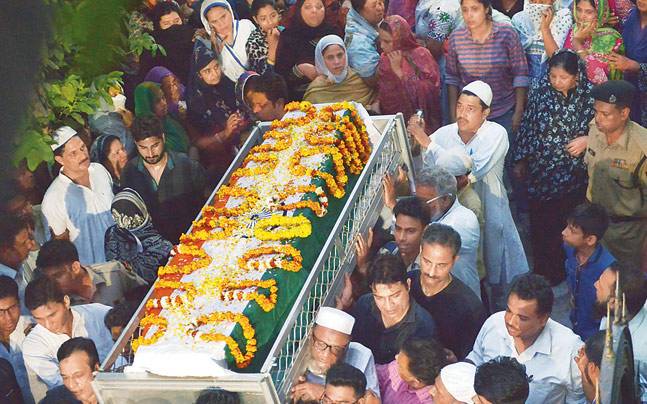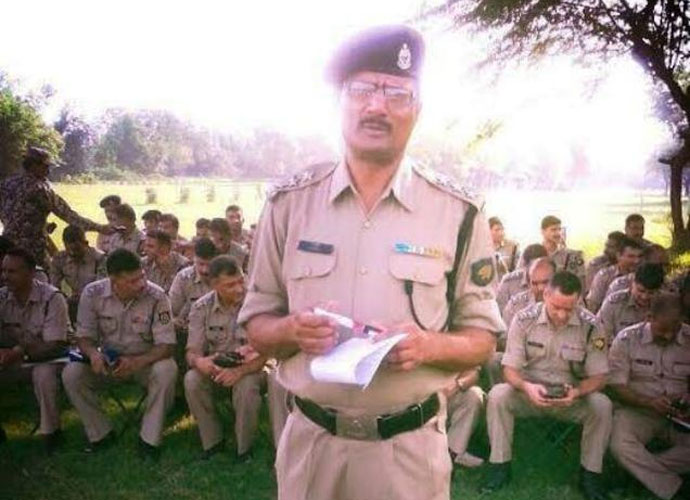The Modi ruled Central Government and its Representatives were Conspicuous in their Absence at the NIA Officer's Funeral

Image: India Today
Surrounded by grief-struck, friends and family, inconsolable in their loss and angry too, at the absence of any government presence or acknowldgement of the tragedy, deputy superintendent Mohammad Tanzil Ahmed, was laid to rest yesterday.
This 45 year-old officer from India's premier security organisation, the National Investigation Agency (NIA) that was formed expressly to investigate terror cases was shot dead on the midnight of April 3 and 4, while returning from a wedding at midnight with his wife and two children in Uttar Pradesh's Bijnor – his home town. Tenzil's wife, Farzana, suffered four bullet injuries and remains in a critical condition at a hospital on the outskirts of Delhi. The wedding that the family was attending was of Tanzil Ahmed's niece.
It was around sunset yesterday, April 4 when the coffin was lowered, with the rays of the setting sun reflecting off it. On the outside was draped the Indian tricolour, reminding us that he has been officially recognised as a martyr.
Mohammad Tanzil Ahmed was part of a team which was probing the Pathankot Air Force Station attack and had handled several high profile cases in the past. Reports indicate that it was he who was instrumental in clamping down on the home-grown terror outfit Indian Mujahideen (IM) and had a big role in the arrest of its chief Yasin Bhatkal in 2013. Yet for those in power in Delhi actions such as these mean little especially if you are a Mohammad Tanzil Ahmed. He was on leave after a five-member joint investigation team (JIT) from Pakistan – which was sent to investigate the Pathankot attack had left the country, enjoying a few quiet days with his family when tragedy struck.

NIA officer Tanzil Ahmed.
Reports say that he also played a role in busting an Islamic State (ISIS) module which led to several arrests, including those in Delhi. Though speculation remains rife about the mens rea behind the murder of Tanzil, investigation agencies haven't ruled out a possible terror angle.
The 21 bullets that were fired at Tanzil left little to chance. The phrase 'he was investigating the terrorist attack on the air base' does not particularly clarify the complexities behind the attack on him.
As the plank of the coffin in which Tanzil’s body arrived was lifted, a fresh wave of grief swept through the mourners. And a palpable anger was felt. Dressed in white kurta-salwar, men of all ages had gathered around the Jamia Millia University, the spot for the final adieu.
While top officers of the the NIA, police and Border Security Force (BSF) – which he was initially recruited to – were present, paying a dignified homage, significantly , there were no signs of any minister from the central government. The vehicle in which the body arrived belonged to the BSF and was decorated with flowers.
The family members were anguished, and a restlessness surrounded the place where his body was placed. "Not a single official from the Central ministry has come here, they don't want to recognise him as a martyr," said his relative as he addressed a group of youth present.
The end was near, and as the coffin was lowered to the ground, lights were turned on as the sun had, by now, set. Friends, colleagues and of course family had come to bid their final farewell.
"He joined NCC (National Cadet Corps) here and was my close friend. I used to live in the hostel here and he was my mate there too," says a man, who has come wearing formal garments.
Today, a soldier, whose foundation was laid at the university, lies dead buried on its premises while he was serving to eliminate the same terror which his university was accused of being the advocate of.
Why Jamia Millia ? Tanzil was an alumnus of this university. It is the same university that the then chief minister of Gujarat – and now Prime Minister – Narendra Modi described as one which was run on government money and yet was ready "to spend money on lawyers to get terrorists out of jail", after the Batla House encounter in September 2008. He uttered these words again in February 2014 on his campaign journey to become prime minister.
One person from the political class did grace the funeral, however. Chief minister of Delhi, Arvind Kejriwal arrived, prayed for the departed soul and even announced Rs 1 crore reparation for the family, which family members at the scene refused to accept. The chief minister then left. Those gathered at the site raised slogans against the ‘package’ offered to the family.
The atmosphere reverberated with Islamic verses. People were made to stand in rows to read the verses from the final prayer, the jinaza (last rites). All Tanzil’s non-Muslim friends and colleagues stood with their heads down, as namaz was offered. All of them had identification cards around their necks with NIA printed on them. There was silence as the imam (priest) recited the prayer.
The lull broke as a tall man started to talk to the media angrily. "He was handling investigations of the Samjhauta Express blast, Pathankot attack, Bijnor bomb blast, why wasn't security given to such an officer?" he questions, demanding compensation for the family. There are also demands that the Central government to declare him as a martyr as people shout "Kendriya Sarkar Murdabad" (Down with Central government).
While the anger bursts forth, the last rites have been completed, the coffin closed and was, by now now ready for the final journey. The tricolour is now back on the coffin, as the march past band of the BSF leads the way. The graveyard isn't far; it's behind the hostel of the Jamia Millia University. It was where Tanzil lived as a student.
The wreath has been laid on the coffin, the grave has been dug and as the body reaches the spot, it is lowered in homage and dignity. It is now time for the official salute, the guns are raised and fired, three times as is due to an officer in command. All mourners have bowed their heads in respect for the final moment.
An officer from the NIA hands over the tricolour that had been draped in homage over Tanzil’s coffin, to Tanzil's brother and says a few words. Tanzil's teenage son is present, standing in front as the body is laid to rest. Mourners put handfuls of soil to fill the grave. Prayers are offered again. Slowly people begin to leave. Dust surrounds the air as everyone leaves the graveyard. Tanzil is laid to rest, mourned by his family, friends and colleagues, but seemingly callously forgotten by the state.
A few stay back. Tanzil's brothers look desolate and disturbed.
